Culture of Anoectochilus
Deep Forest Jewel Orchids
Jewel Orchid Cultural Information by Michael Dorris Anoectochilus is from the Greek "Open Lip", created in 1825 by Carl Blume in "Bijdragen Tot de Flora of Nederlandsch Indies". This genus contains 20 to 40 species and is generally regarded as having 20 chromosomes. Mistaken for Macodes by a number of collectors, the column does not twist in Anoectochilus. Their white to yellow flowers have a feathery lip; other genera also can have this sort of lip like Pristiglottis. They have some of the best flowers of any jewel orchid. Leaves can get up to 4 in (10 cm) long. Brown toned to green leaves, silver or white veins in most, sometimes red and pink veins.
Cultivation. Anoectochilus is a primary forest genus intolerant of disturbance and is one of the lower light loving jewel orchid. It grows easily in well drained hilly areas with thick humus, fragmentary data suggest a soil pH of 5.5 to 6. Prefers temperatures in the 60F to 90F (15C to 30C) range generally.
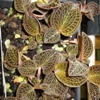 Anoectochilus albo-lineatus Par.et Rchb.f., the species name meaning "white lines", seems to naturally cross with Anoectochilus reinwardtii and is related to it.
Found in Burma, Thailand and Malaysia in mountain forests at 3,600 to 5,000 ft (1200 to 1700 m).
It is a smaller sized, warm to cool growing orchid with a dark purplish, red to copper to white veined leaf that is oval ending in a point and velvety textured.
Blooms in the spring and summer on a 5 inch spike (12.5 cm).
This is an uncommon specie in the trade but a very nice orchid with lots of genetic diversity and so has been called almost every name in the book including the green-yellow leafed Macodes petola.
Anoectochilus albo-lineatus Par.et Rchb.f., the species name meaning "white lines", seems to naturally cross with Anoectochilus reinwardtii and is related to it.
Found in Burma, Thailand and Malaysia in mountain forests at 3,600 to 5,000 ft (1200 to 1700 m).
It is a smaller sized, warm to cool growing orchid with a dark purplish, red to copper to white veined leaf that is oval ending in a point and velvety textured.
Blooms in the spring and summer on a 5 inch spike (12.5 cm).
This is an uncommon specie in the trade but a very nice orchid with lots of genetic diversity and so has been called almost every name in the book including the green-yellow leafed Macodes petola.
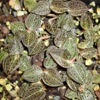 Anoectochilus brevilabris
is an eastern Himalayan terrestrial species that seems to be genetically diverse and sometime is found under the name Anct. sikkimensis.
Far more plants are being called Anct. brevilabris than should be.
Has either 30 or 40 chromosomes depending on the reference.
Growing from 3000 to 4500 ft (1000 to 1500 m). At this elevation, it is subtropical. Dark, ovate leaves with pale golden to orange veins and a distinct point. A summer bloomer.
Seems very close to Anoectochilus reinwardtii in a number of ways but is cooler growing and the ranges don't overlap.
Anoectochilus brevilabris
is an eastern Himalayan terrestrial species that seems to be genetically diverse and sometime is found under the name Anct. sikkimensis.
Far more plants are being called Anct. brevilabris than should be.
Has either 30 or 40 chromosomes depending on the reference.
Growing from 3000 to 4500 ft (1000 to 1500 m). At this elevation, it is subtropical. Dark, ovate leaves with pale golden to orange veins and a distinct point. A summer bloomer.
Seems very close to Anoectochilus reinwardtii in a number of ways but is cooler growing and the ranges don't overlap.
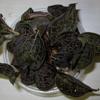 Anoectochilus chapaensis
is synonymous with Anct. burmannicus.
Found in Yunnan, China and North Vietnam at about 4,390 ft (1350 m). Regarded as a subtropical to warm growing and terrestrial, but seems to do better as a warm growing plant. This is a burgundy leafed, yellow veined plant.
Leaves are up to 4 in max (10 cm) heart shaped and wavy.
They are slow growing and don't creep much.
Small yellow flowers showing up in winter and spring; might be the only yellow flowering Anoectochilus and the lip points up.
More of a collectors orchid, somewhat common in the plant trade.
Anoectochilus chapaensis
is synonymous with Anct. burmannicus.
Found in Yunnan, China and North Vietnam at about 4,390 ft (1350 m). Regarded as a subtropical to warm growing and terrestrial, but seems to do better as a warm growing plant. This is a burgundy leafed, yellow veined plant.
Leaves are up to 4 in max (10 cm) heart shaped and wavy.
They are slow growing and don't creep much.
Small yellow flowers showing up in winter and spring; might be the only yellow flowering Anoectochilus and the lip points up.
More of a collectors orchid, somewhat common in the plant trade.
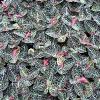 Anoectochilus formosanus,
the silver veined jewel orchid.
Named after the island of Formosa, or Taiwan, where it grows and on the nearby Lanyu island, the Japanese Ryukyu islands and in Fujian province of mainland China.
The Japanese form has less leaf netting.
It is closely related to a number of other Anoectochilus like Anct. setaceus and Anct. yungianus scattered over SE Asia.
Deep green heart shaped leaves with silver veins, red burgundy undersides and a white-yellow lobbed lip.
Creeps and branches well. Leaves up to 2 in (5 cm) long.
Easy to grow as long as you keep the light low, 500 fc or light you can read a newspaper under. Can take temperatures from 35F (2C) to 95F (36C), grows best at 70F (22C).
This plant blooms in winter and the leaves can turn brown in the process; it can be encouraged to bloom with stronger light.
Overall its an easy grower and miniature. It does collect leaf mites when the humidity is low, below 50%, misting daily can control mite.
Anoectochilus formosanus,
the silver veined jewel orchid.
Named after the island of Formosa, or Taiwan, where it grows and on the nearby Lanyu island, the Japanese Ryukyu islands and in Fujian province of mainland China.
The Japanese form has less leaf netting.
It is closely related to a number of other Anoectochilus like Anct. setaceus and Anct. yungianus scattered over SE Asia.
Deep green heart shaped leaves with silver veins, red burgundy undersides and a white-yellow lobbed lip.
Creeps and branches well. Leaves up to 2 in (5 cm) long.
Easy to grow as long as you keep the light low, 500 fc or light you can read a newspaper under. Can take temperatures from 35F (2C) to 95F (36C), grows best at 70F (22C).
This plant blooms in winter and the leaves can turn brown in the process; it can be encouraged to bloom with stronger light.
Overall its an easy grower and miniature. It does collect leaf mites when the humidity is low, below 50%, misting daily can control mite."In Taiwanese folk remedies, the whole plant of Anct. formosanus, know as "golden line lotus" is used fresh or dried, boiled in water and taken internally to treat chest and abdominal pains, diabetes, nephritis, fever, hypertension, impotence, liver and spleen disorders and pleurodynia. The fresh herb is applied externally as a treatment for snake-bite. The current market price of the fresh herb collected from its natural habitat is around US$320 per kilogram, while the dried herb sells for US$3200 per kilogram."- from Use of Tissue Culture for the Mass Propagation of Pathogen-Free Plants, by Hsin-Sheng Tsay. You can also get this jewel orchid boiled with chicken in Taiwan and it is one of the better tasting ones.
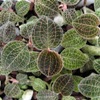 Anoectochilus geniculatus
Ridl. 1896.
Found in SE Asia to Borneo, and Sumatra in higher elevation tropical rain forests from 1970 ft (600 m) to 3612 ft (1100 m). It prefers to creep with roots at the nodes. Grows in warm to hot conditions. It has the typical Anoectochilus frilly lip on the flower. This species can very in size depending on culture, stronger light encourages creeping whereas lower light encourages the plants to vine upwards looking for support.
Anoectochilus geniculatus
Ridl. 1896.
Found in SE Asia to Borneo, and Sumatra in higher elevation tropical rain forests from 1970 ft (600 m) to 3612 ft (1100 m). It prefers to creep with roots at the nodes. Grows in warm to hot conditions. It has the typical Anoectochilus frilly lip on the flower. This species can very in size depending on culture, stronger light encourages creeping whereas lower light encourages the plants to vine upwards looking for support.
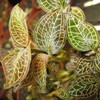 Anoectochilus reinwardtii
Bl., Coll. Orch.Arch.Ind. Jav.:48 (1858). It is a low land tropical plant of Sumatra and Borneo, so a warm growing plant.
Can be seen as a type of Anoectochilus albo-lineatus.
Prefers the humus and mosses of the dark forest floor.
Nice copper veins. An easy plant to grow.
Anoectochilus reinwardtii
Bl., Coll. Orch.Arch.Ind. Jav.:48 (1858). It is a low land tropical plant of Sumatra and Borneo, so a warm growing plant.
Can be seen as a type of Anoectochilus albo-lineatus.
Prefers the humus and mosses of the dark forest floor.
Nice copper veins. An easy plant to grow.
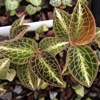 Anoectochilus roxburghii,
the pink veined jewel orchid or Roxburgh's jewel orchid, synonymous with Anct. lobbianum; with 30 chromosomes.
Found in the Himalayas, Assam, Bangladesh, Nepal, Sri Lanka, Bhutan, Thailand, Laos, Yunnan China, Vietnam, Java and Sumatra in broad leaf, evergreen, primary forests.
Tends to be along watercourses at elevations lower then 1000 ft (300 m).
Generally a warm growing terrestrial orchid, likes rich humus.
Flower spikes are up to 10 in (25 cm) tall.
Described as flowering in the summer.
The true species has wide veins, pink tinted with a center white band running down along the midrib, generally golden overall.
Always irridescent.
A nice plant, a bit soft and leggy at times.
Easy to grow once you provide the right light and the plant matures.
Anoectochilus roxburghii,
the pink veined jewel orchid or Roxburgh's jewel orchid, synonymous with Anct. lobbianum; with 30 chromosomes.
Found in the Himalayas, Assam, Bangladesh, Nepal, Sri Lanka, Bhutan, Thailand, Laos, Yunnan China, Vietnam, Java and Sumatra in broad leaf, evergreen, primary forests.
Tends to be along watercourses at elevations lower then 1000 ft (300 m).
Generally a warm growing terrestrial orchid, likes rich humus.
Flower spikes are up to 10 in (25 cm) tall.
Described as flowering in the summer.
The true species has wide veins, pink tinted with a center white band running down along the midrib, generally golden overall.
Always irridescent.
A nice plant, a bit soft and leggy at times.
Easy to grow once you provide the right light and the plant matures.